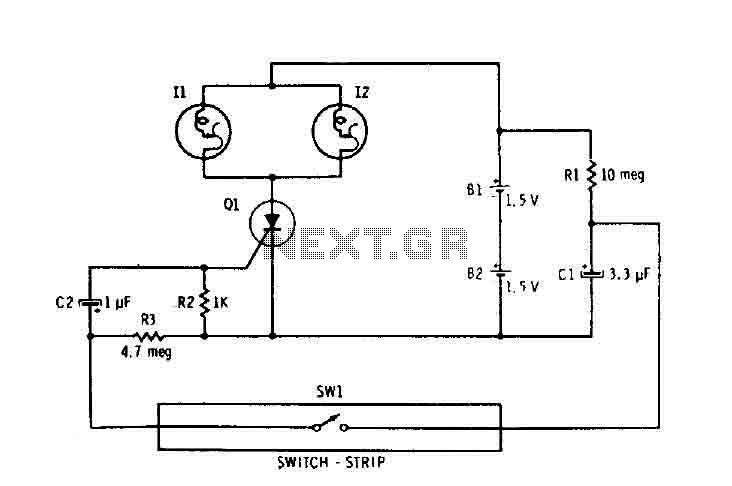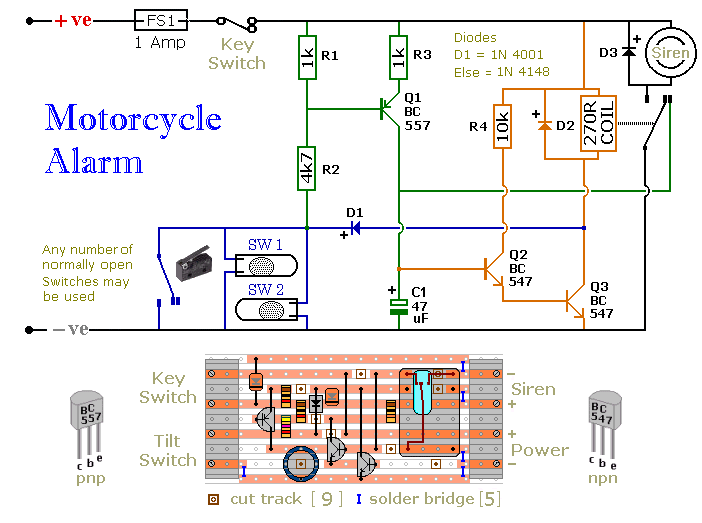
Car Alarm Simulator

This is a car alarm simulator that uses an LED as a simulation output. This simple circuit can indicate whether a car is running or not by detecting the voltage difference when the car is on and off. This occurs because when the car is running, the alternator outputs a voltage slightly higher than when the car is off. This circuit is available as a kit, but it is also feasible to build a car alarm simulator circuit independently.
The car alarm simulator circuit operates by utilizing the voltage produced by the vehicle's alternator. When the car engine is running, the alternator generates a higher voltage, typically around 13.8 to 14.4 volts, compared to the resting voltage of approximately 12 volts when the engine is off. This voltage difference can be harnessed to activate an LED, providing a visual indication of the car's operational status.
The core components of the circuit include a voltage comparator, an LED, and resistors for current limiting. The voltage comparator is configured to compare the voltage levels from the vehicle's battery and alternator. When the engine is off, the comparator detects a lower voltage and keeps the LED turned off. Conversely, when the engine is started, the increased voltage from the alternator triggers the comparator, which then allows current to flow through the LED, illuminating it to signal that the car is running.
In terms of construction, the circuit can be built on a breadboard or a printed circuit board (PCB) for a more permanent solution. The LED should be chosen based on the desired brightness and visibility, while the resistors must be calculated to ensure that the LED receives the appropriate current without exceeding its maximum ratings. Additional features, such as a buzzer or additional LEDs for different statuses, can be incorporated for enhanced functionality.
Overall, this car alarm simulator circuit serves as a useful tool for vehicle owners to easily monitor their car's engine status, providing both educational and practical applications in automotive electronics.This is a car alarm simulator which using the LED as a simulation output. This simple circuit can tell you whether your car is running or not by detecting the voltage difference when the car is on and off. This occurs because when your car This is a car alarm simulator which using the LED as a simulation output.
This simple circuit can tel l you whether your car is running or not by detecting the voltage difference when the car is on and off. This occurs because when your car is running the Alternator puts a out a voltage a little bit higher than when the car is off.
This circuit actually is a kits, you can get the kits at But it is very possible to you to build your own car alarm simulator circuit. 🔗 External reference
The car alarm simulator circuit operates by utilizing the voltage produced by the vehicle's alternator. When the car engine is running, the alternator generates a higher voltage, typically around 13.8 to 14.4 volts, compared to the resting voltage of approximately 12 volts when the engine is off. This voltage difference can be harnessed to activate an LED, providing a visual indication of the car's operational status.
The core components of the circuit include a voltage comparator, an LED, and resistors for current limiting. The voltage comparator is configured to compare the voltage levels from the vehicle's battery and alternator. When the engine is off, the comparator detects a lower voltage and keeps the LED turned off. Conversely, when the engine is started, the increased voltage from the alternator triggers the comparator, which then allows current to flow through the LED, illuminating it to signal that the car is running.
In terms of construction, the circuit can be built on a breadboard or a printed circuit board (PCB) for a more permanent solution. The LED should be chosen based on the desired brightness and visibility, while the resistors must be calculated to ensure that the LED receives the appropriate current without exceeding its maximum ratings. Additional features, such as a buzzer or additional LEDs for different statuses, can be incorporated for enhanced functionality.
Overall, this car alarm simulator circuit serves as a useful tool for vehicle owners to easily monitor their car's engine status, providing both educational and practical applications in automotive electronics.This is a car alarm simulator which using the LED as a simulation output. This simple circuit can tell you whether your car is running or not by detecting the voltage difference when the car is on and off. This occurs because when your car This is a car alarm simulator which using the LED as a simulation output.
This simple circuit can tel l you whether your car is running or not by detecting the voltage difference when the car is on and off. This occurs because when your car is running the Alternator puts a out a voltage a little bit higher than when the car is off.
This circuit actually is a kits, you can get the kits at But it is very possible to you to build your own car alarm simulator circuit. 🔗 External reference





